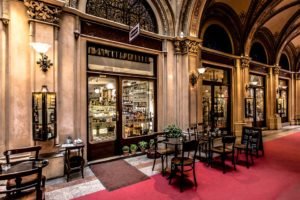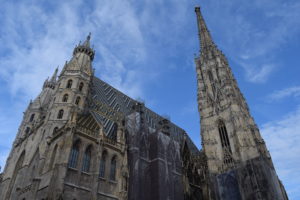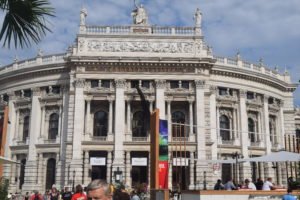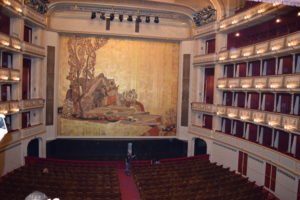
Vienna or Wien is known as The City of Dreams, City of Music and it’s no exaggeration. Ranked top in ‘Quality of Life’ index, Vienna is a flourishing modern city retaining it’s medieval glory and musical legacy. The entire city centre is a UNESCO Heritage Site, you won’t have to ‘look out’ for tourist places, the whole city is an architectural marvel with Baroque, Medieval and Modern architecture, enchanting art galleries, majestic museums, grand opera houses, throbbing shopping districts, thriving coffee scene and a stunning fashion sense. A 13th century cathedral goes hand in hand with an upmarket street dotted with high fashion stores and people on the street dressed like they came for a ramp walk.

(Image credit: Pixabay)
Vienna is an important Central European city and host to United Nations and OPEC. It is a case study for Urban City Planners ranking high on ‘Innovative Cities Index’ in terms of culture, infrastructure and markets. It boasts of an excellent public transport with a network of underground metro and tram line in the city centre. Some of the key attractions not to be missed are:

Schonburnn Palace: Located 5 km away from the city centre, Schonburnn Palace is Vienna’s most popular tourist destinations and a fine example of Baroque architecture. It carries immense historic significance being the summer residence of the Hapsburgs for centuries. Emperor Franz Joseph was born and breathed his last, here. Napoleon held meetings in one of the stately rooms. Out of its 1441 rooms, 45 are open to public and stand testimony to the classic Baroque architecture. Young prodigy Mozart at the age of six played music in the famous Mirror Room to Queen. The Palace complex has huge sculpted gardens, beautiful fountain atop a hill, a botanical garden and zoological park dating back to 18th century.

St Stephen’s Cathedral: The Romanesque, Gothic Cathedral is Vienna’s most visible architectural symbol and Austria’s finest Gothic structure. Situated in the city centre, the South Tower rises 136 meters, it is an iconic landmark recognizable all over Vienna’s skyline. Go up 300 steps in the tower and you will get beautiful views of the city. The roof of the cathedral is tiled with beautiful coloured tiles in zigzag pattern. The interior is as grand and beautiful as the exterior housing the second largest free swinging church bell in Europe. The ornate interior will mesmerise you with beautiful statues, paintings, gilded wooden figurines and stained glass work.

The Hofburg Palace: Hofburg Palace is the former imperial palace of the Habsburg dynasty rulers and now it serves as the official seat and residence of the President of Austria. Dating back to 13th century it served as the winter palace and, the summer palace. Today the complex houses numerous museums from the Imperial era like the Imperial Silver Museum, Imperial Treasury Vienna, Imperial Apartments and Spanish Riding School to give you a glimpse into the splendour and life of the Royals.

Vienna State Opera House: One of the world’s largest and most magnificent opera houses in the world, it was inaugurated in 1869 with Mozart’s ‘Don Giovanni’ as its first night performance in the presence of Emperor Franz Joseph I and Empress Elisabeth of Austria. The Vienna Opera Ball, Austria’s leading high society event, is conducted here every year. A tour around the complex, the gold and red traditional seating, high balconies, statuesque curtains on the stage, will transport you to a different era.

Kunsthistorisches Museum: Largest Art Museum in the Austria and an important museum in the world, it is housed inside a beautiful rectangular building on Ringstrause topped with an octagonal dome. It displays the large art collection of the Hapsburgs with some notable works from European art history. Other than the art collection, the building is no less than a remarkable work of architecture.

(Image credit: Pixabay)
Vienna’s City Hall (Weiner Rathaus): An impressive Neo Gothic structure, Rathaus serves as the city’s administrative centre. The huge open space in front often hosts musical performances and other events.

The Museum Quarter: The Museum Quarter district is an eclectic mix of old and new buildings housing art museums, cafes, restaurants, bars and open space to spend a day. You will see many artists and creative types hanging around here. It hosts the annual summer festival. It houses the noted Leopold Museum, Museum of Modern Art (MUMOK) and has art studios for artists, design studios, media production studios, cultural facilities for children, dance festivals and many other events hosted here.
“You need some reason why Beethoven, Mozart and Haydn in the 18th century all flocked to Vienna. What was it about Vienna? They must have known on some level that that is where they would flourish. It’s what biologists call “selective migration.” Eric Weiner
“If you walk into a coffee shop in 1903 Vienna, you might find at the same table the artist Gustav Klimt, Sigmund Freud, Leon Trotsky and possibly Adolf Hitler, who lived in Vienna at the same time.” – Eric Weiner
Thanks for the guide. Vienna looks like an amazing city to visit.
It’s a wonderful city. Thanks for dropping by Sinjana 🙂